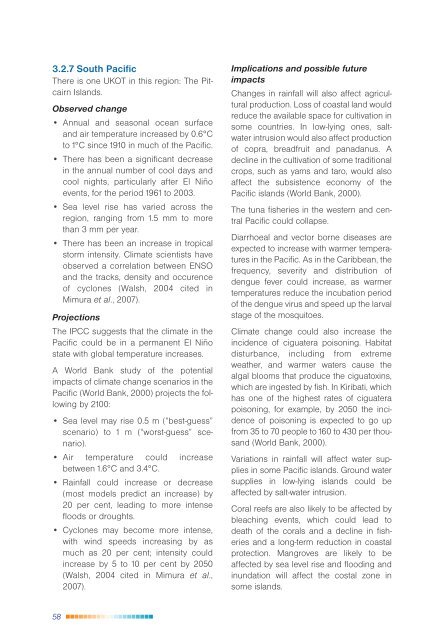Climate change in the UKOTs an overview of the ... - JNCC - Defra
Climate change in the UKOTs an overview of the ... - JNCC - Defra
Climate change in the UKOTs an overview of the ... - JNCC - Defra
Create successful ePaper yourself
Turn your PDF publications into a flip-book with our unique Google optimized e-Paper software.
3.2.7 South Pacific<br />
There is one UKOT <strong>in</strong> this region: The Pitcairn<br />
Isl<strong>an</strong>ds.<br />
Observed <strong>ch<strong>an</strong>ge</strong><br />
• Annual <strong>an</strong>d seasonal oce<strong>an</strong> surface<br />
<strong>an</strong>d air temperature <strong>in</strong>creased by 0.6°C<br />
to 1°C s<strong>in</strong>ce 1910 <strong>in</strong> much <strong>of</strong> <strong>the</strong> Pacific.<br />
• There has been a signific<strong>an</strong>t decrease<br />
<strong>in</strong> <strong>the</strong> <strong>an</strong>nual number <strong>of</strong> cool days <strong>an</strong>d<br />
cool nights, particularly after El Niño<br />
events, for <strong>the</strong> period 1961 to 2003.<br />
• Sea level rise has varied across <strong>the</strong><br />
region, r<strong>an</strong>g<strong>in</strong>g from 1.5 mm to more<br />
th<strong>an</strong> 3 mm per year.<br />
• There has been <strong>an</strong> <strong>in</strong>crease <strong>in</strong> tropical<br />
storm <strong>in</strong>tensity. <strong>Climate</strong> scientists have<br />
observed a correlation between ENSO<br />
<strong>an</strong>d <strong>the</strong> tracks, density <strong>an</strong>d occurence<br />
<strong>of</strong> cyclones (Walsh, 2004 cited <strong>in</strong><br />
Mimura et al., 2007).<br />
Projections<br />
The IPCC suggests that <strong>the</strong> climate <strong>in</strong> <strong>the</strong><br />
Pacific could be <strong>in</strong> a perm<strong>an</strong>ent El Niño<br />
state with global temperature <strong>in</strong>creases.<br />
A World B<strong>an</strong>k study <strong>of</strong> <strong>the</strong> potential<br />
impacts <strong>of</strong> climate <strong>ch<strong>an</strong>ge</strong> scenarios <strong>in</strong> <strong>the</strong><br />
Pacific (World B<strong>an</strong>k, 2000) projects <strong>the</strong> follow<strong>in</strong>g<br />
by 2100:<br />
• Sea level may rise 0.5 m (“best-guess”<br />
scenario) to 1 m (“worst-guess” scenario).<br />
• Air temperature could <strong>in</strong>crease<br />
between 1.6°C <strong>an</strong>d 3.4°C.<br />
• Ra<strong>in</strong>fall could <strong>in</strong>crease or decrease<br />
(most models predict <strong>an</strong> <strong>in</strong>crease) by<br />
20 per cent, lead<strong>in</strong>g to more <strong>in</strong>tense<br />
floods or droughts.<br />
• Cyclones may become more <strong>in</strong>tense,<br />
with w<strong>in</strong>d speeds <strong>in</strong>creas<strong>in</strong>g by as<br />
much as 20 per cent; <strong>in</strong>tensity could<br />
<strong>in</strong>crease by 5 to 10 per cent by 2050<br />
(Walsh, 2004 cited <strong>in</strong> Mimura et al.,<br />
2007).<br />
58<br />
Implications <strong>an</strong>d possible future<br />
impacts<br />
Ch<strong>an</strong>ges <strong>in</strong> ra<strong>in</strong>fall will also affect agricultural<br />
production. Loss <strong>of</strong> coastal l<strong>an</strong>d would<br />
reduce <strong>the</strong> available space for cultivation <strong>in</strong><br />
some countries. In low-ly<strong>in</strong>g ones, saltwater<br />
<strong>in</strong>trusion would also affect production<br />
<strong>of</strong> copra, breadfruit <strong>an</strong>d p<strong>an</strong>ad<strong>an</strong>us. A<br />
decl<strong>in</strong>e <strong>in</strong> <strong>the</strong> cultivation <strong>of</strong> some traditional<br />
crops, such as yams <strong>an</strong>d taro, would also<br />
affect <strong>the</strong> subsistence economy <strong>of</strong> <strong>the</strong><br />
Pacific isl<strong>an</strong>ds (World B<strong>an</strong>k, 2000).<br />
The tuna fisheries <strong>in</strong> <strong>the</strong> western <strong>an</strong>d central<br />
Pacific could collapse.<br />
Diarrhoeal <strong>an</strong>d vector borne diseases are<br />
expected to <strong>in</strong>crease with warmer temperatures<br />
<strong>in</strong> <strong>the</strong> Pacific. As <strong>in</strong> <strong>the</strong> Caribbe<strong>an</strong>, <strong>the</strong><br />
frequency, severity <strong>an</strong>d distribution <strong>of</strong><br />
dengue fever could <strong>in</strong>crease, as warmer<br />
temperatures reduce <strong>the</strong> <strong>in</strong>cubation period<br />
<strong>of</strong> <strong>the</strong> dengue virus <strong>an</strong>d speed up <strong>the</strong> larval<br />
stage <strong>of</strong> <strong>the</strong> mosquitoes.<br />
<strong>Climate</strong> <strong>ch<strong>an</strong>ge</strong> could also <strong>in</strong>crease <strong>the</strong><br />
<strong>in</strong>cidence <strong>of</strong> ciguatera poison<strong>in</strong>g. Habitat<br />
disturb<strong>an</strong>ce, <strong>in</strong>clud<strong>in</strong>g from extreme<br />
wea<strong>the</strong>r, <strong>an</strong>d warmer waters cause <strong>the</strong><br />
algal blooms that produce <strong>the</strong> ciguatox<strong>in</strong>s,<br />
which are <strong>in</strong>gested by fish. In Kiribati, which<br />
has one <strong>of</strong> <strong>the</strong> highest rates <strong>of</strong> ciguatera<br />
poison<strong>in</strong>g, for example, by 2050 <strong>the</strong> <strong>in</strong>cidence<br />
<strong>of</strong> poison<strong>in</strong>g is expected to go up<br />
from 35 to 70 people to 160 to 430 per thous<strong>an</strong>d<br />
(World B<strong>an</strong>k, 2000).<br />
Variations <strong>in</strong> ra<strong>in</strong>fall will affect water supplies<br />
<strong>in</strong> some Pacific isl<strong>an</strong>ds. Ground water<br />
supplies <strong>in</strong> low-ly<strong>in</strong>g isl<strong>an</strong>ds could be<br />
affected by salt-water <strong>in</strong>trusion.<br />
Coral reefs are also likely to be affected by<br />
bleach<strong>in</strong>g events, which could lead to<br />
death <strong>of</strong> <strong>the</strong> corals <strong>an</strong>d a decl<strong>in</strong>e <strong>in</strong> fisheries<br />
<strong>an</strong>d a long-term reduction <strong>in</strong> coastal<br />
protection. M<strong>an</strong>groves are likely to be<br />
affected by sea level rise <strong>an</strong>d flood<strong>in</strong>g <strong>an</strong>d<br />
<strong>in</strong>undation will affect <strong>the</strong> costal zone <strong>in</strong><br />
some isl<strong>an</strong>ds.

















